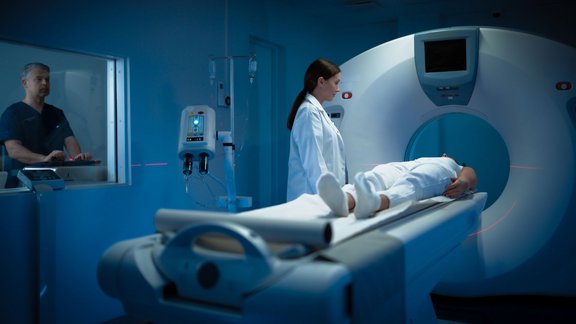Interoperability is revolutionizing healthcare by enabling the seamless exchange of patient data across systems. This efficient data flow is critical not only for improving patient care but also for streamlining healthcare operations across hospitals, pharmacies, and medical practices.
While Germany continues to face challenges in achieving high interoperability between healthcare systems, other countries have made significant progress, paving the way for a more integrated future. [1]
At its core, interoperability ensures that healthcare systems can communicate and share information effectively. To achieve this, it is essential that data is standardized – both structurally and semantically – so it can be interpreted and used across different systems. [2][3] The goal is to provide real-time access to a patient's relevant data, all from a centralized location. [4]
One of the key enablers of this seamless integration is FHIR (Fast Healthcare Interoperability Resources). FHIR is an open-source framework designed to streamline healthcare data management. It organizes health information into standardized "resources," making it easier for different systems, from mobile apps to large institutional servers, to share and interpret data. [5] This data exchange not only benefits healthcare professionals like doctors and pharmacists but also fosters innovation across the industry. [6] More importantly, it empowers patients, giving them better control over their health data and enhancing their access to vital health records. [7]
In a recent interview, we had the opportunity to sit down with Mint Medical’s Director of Research and Development, Johannes Kast, to discuss the importance of interoperability, its challenges and benefits, as well as the role of AI in shaping the future of healthcare. You can read the full interview here or watch the entire conversation on YouTube.
Why is interoperability crucial in healthcare today?
Future hospital systems won’t be one big, monolithic software; instead they’ll consist of many specialized applications and AI models which are working together seamlessly. Physicians today are overloaded with documents. These documents rarely provide detailed and context-specific information needed at the point of care. Currently, healthcare systems rely heavily on documents, but clinical workflows and user interactions require specific and detailed information. So what we need is a ubiquitous user experience, where the user no longer recognizes that they are working with many systems in the background and they no longer need to rely on the content of one document.
For example, a radiologist preparing a CT scan may only need immediate information on a patient’s contrast agent allergies and not their entire medical history. Or clinicians may only need exact data points like tumor measurements rather than a full radiological report. Today’s systems struggle to efficiently deliver this precise and context sensitive data.
How can artificial intelligence bridge this gap?
Large Language Models (LLMs) can extract structured data from unstructured documents. However, extraction alone can introduce errors because human language is inherently ambiguous. The best approach is capturing structured data at the moment it is created. AI can support this process by immediately highlighting inconsistencies or by suggesting missing information during clinical assessments. Physicians can then instantly verify, accept, or correct these suggestions, creating accurate structured data right at the source, reducing ambiguities inherent in natural language. This structured data can then improve AI systems, effectively closing the feedback loop needed to train more accurate and reliable AI.
Practically, how do we achieve interoperability?
We achieve interoperability by adopting a common data standard. And currently, FHIR is our best option. It's widely adopted and specifically designed to handle detailed clinical information. FHIR not just covers patient clinical data, it also covers procedures, workflows, and other healthcare interactions.
However, fragmented FHIR profile development is a significant challenge. Many groups create profiles for specific use cases, limiting their broader use. Instead, we need broader, reusable concepts and better collaboration between researchers, interoperability initiatives, and technology vendors.
Concepts can be as simple as a radiology report or referencing a specific lesion or an anatomical structure within our profiles. Another crucial concept is consistently tracking certain types of information over time. Focusing on foundational concepts rather than narrow use cases ensures a flexible, interoperable framework for diverse clinical scenarios.
How does Mint Medical support this vision?
Mint Medical offers solutions for structured data acquisition in radiology. Our software helps clinicians seamlessly capture detailed and context-sensitive information. We also closely integrate AI technologies from different vendors, especially the anatomical model from our colleagues from SNKE, therefore enriching structured AI data with additional clinical context. This significantly enhances data accuracy and the speed at which structured information can be recorded.
For instance, our software identifies precisely which anatomical structures radiologists are currently interacting with. This allows clinicians to easily record meaningful and structured information at the point of care.
Mint Medical also collaborates closely with healthcare institutions to deliver detailed, FHIR-compliant data exports. These high-quality, structured datasets maintain essential context and can be reliably used for research and AI training. This creates a feedback loop that continuously improves healthcare quality.
Ultimately, this brings us back to our initial vision – a seamless, context-sensitive environment where structured data supports better clinical decisions and patient outcomes.
[1] Kostera, Thomas. 2020. “Elektronische Rezepte: Schlüsselfaktor Anschlussfähigkeit.” Programm Gesundheit. https://www.programm-gesundheit.blog/e-rezept/.
[2] “Interoperabilität mit FHIR: Struktur in medizinische Daten bringen.” Medical Values. https://medicalvalues.de/de/interoperabilitaet-mit-fhir-struktur-in-medizinische-daten-bringen/.
[3] Weber Stefanie & Kai U. Heitmann. 2021. "Interoperabilität im Gesundheitswesen: auch für digitale Gesundheitsanwendungen (DiGA) verordnet.” Bundesgesundheitsblatt Gesundheitsforschung Gesundheitsschutz 64.10: 1262-1268.
[4] Dr. Russel Leftwich. 2023. “The Concept of FHIR: A Healthcare Data Standard Designed for the Future.” Inter Systems Learning Services. https://www.youtube.com/watch?v=fv2xTR_0QnA.
[5] HL7 FHIR. 2022. “Introducing HL7 FHIR.” HL7, https://hl7.org/fhir/R4B/summary.html
[6] Lamprinakos, Georgios C. et al. 2014. “Using FHIR to develop a healthcare mobile application.” 2014 4th International Conference on Wireless Mobile Communication and Healthcare - Transforming Healthcare Through Innovations in Mobile and Wireless Technologies (MOBIHEALTH), Athens, Greece, 2014, 132-135.
[7] Saripalle, Rishi, Christoper Runyan & Mitchell Russell. 2019. “Using HL7 FHIR to achieve interoperability in patient health record.” Journal of Biomedical Informatics 94.



